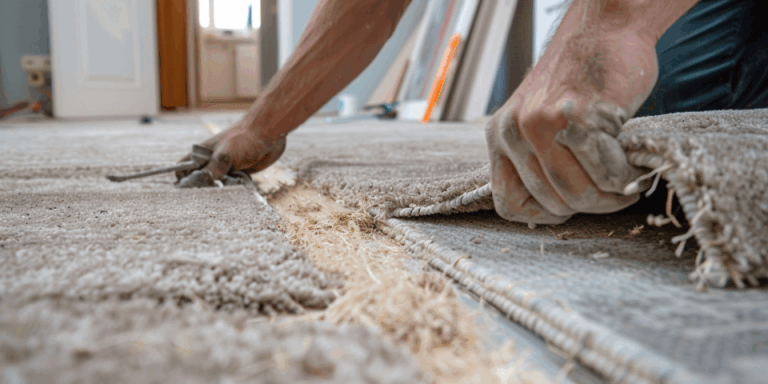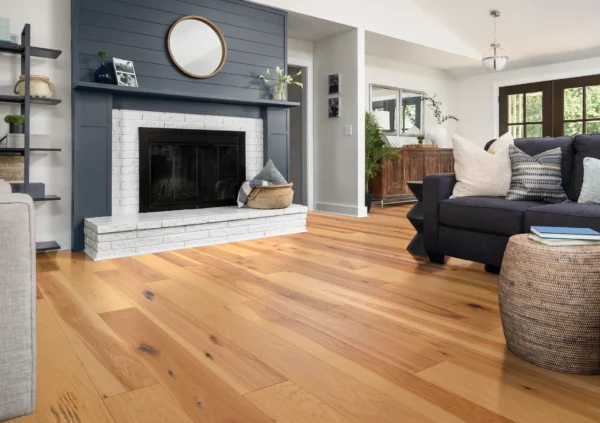
Everything You’ll Need
| Tool/Material | Carpet Tile | Stretch-In | Glue-Down | Purpose |
|---|---|---|---|---|
| Utility Knife | ✔ | ✔ | ✔ | Cut carpet/padding |
| Tape Measure | ✔ | ✔ | ✔ | Measure dimensions |
| Straight Edge | ✔ | ✔ | ✔ | Guide straight cuts |
| Chalk Line | ✔ | ✔ | ✔ | Mark layout lines |
| Pry Bar | ✔ | ✔ | ✔ | Remove baseboards/flooring |
| Knee Pads | ✔ | ✔ | ✔ | Protect knees |
| Tack Strips | ❌ | ✔ | Optional | Secure carpet edges |
| Double-Sided Tape | ✔ | ❌ | ❌ | Adhere carpet tiles |
| Carpet Adhesive | Optional | ❌ | ✔ | Glue carpet |
| Staple Gun | ❌ | ✔ | ✔ | Secure underlay (wood only) |
| Seaming Tape & Iron | ✔ | ✔ | ✔ | Join seams |
| Knee Kicker | ❌ | ✔ | ❌ | Stretch carpet |
| Power Stretcher | ❌ | ✔ | ❌ | Stretch carpet |
| Stair Tool | ✔ | ✔ | ✔ | Tuck carpet edges |
| Carpet Roller | ✔ | Optional | ✔ | Press carpet firmly |
For concrete subfloors: cement filler, construction adhesive, masonry nails.
Quick Notes:
- Carpet tiles often just need tape or adhesive dots and don’t require stretching.
- Stretch-in wall-to-wall carpet needs a knee kicker and power stretcher.
- Glue-down carpet skips the stretcher but requires adhesive and a roller to secure the bond.
Step 1: Removing Old Flooring
Before putting in your new carpet, you should take out the old flooring. If you have an old carpet, wood, or tile, be sure to remove it all. This gives a fresh start for your new carpet.
Step 2: Subfloor Preparation
After taking out the old flooring, clean and get the subfloor ready. Check the floor for any damage or wetness. If putting carpet over concrete, look for moisture and fix any problems first.
Fixing Damage and Uneven Spots
Find and fill cracks, holes, or spaces. For a wooden subfloor, use wood filler for gaps or cracks, then sand smooth when dry.
Use cement filler to fix cracks in concrete subfloors. Also, check for high or low spots. Use a leveling compound to make the surface flat and even.
Fixing these problems helps avoid future wear and tear in uneven areas.
Checking for Moisture
Look for moisture in the subfloor, especially if it’s concrete. Too much moisture can cause mold, mildew, and harm to the subfloor and carpet.
Use a moisture meter to check moisture levels. If they’re too high, fix the problem before moving on.
You might need a moisture barrier or sealant to keep the subfloor dry. Checking and fixing moisture issues can stop future problems and help the carpet last longer.
Step 3: Measuring the Room
Before buying carpet, measure the room’s size carefully. Check both length and width, and include any odd shapes in the room.
Add about 4 inches to your length and width measurements to adjust for wall changes and cutting during carpet fitting.
Handling Irregularities
These odd shapes can make installation tricky and change how your carpet looks. Here are some common challenges:
Alcoves and Bay Windows
Alcoves and bay windows make unique shapes that disturb a room’s usual layout. These spots often need exact measurements and extra carpet pieces for full coverage.
Closets and Doorways
Closets, especially walk-ins, and doorways can break the main carpet flow. Doorways need special transitions between floor types, and closets might need custom carpet pieces.
Angled Walls and Corners
Not all rooms have straight walls. Angled walls and corners make cutting and fitting the carpet harder. These spots need careful work to make the carpet fit well.
Columns and Built-In Features
Columns or built-in items like bookshelves or fireplaces create obstacles for carpet installation. These need precise cutting and fitting around their base for a smooth look.
Irregular Room Shapes
Rooms shaped like L or T add challenges. These need more complex measuring and cutting to fit the carpet properly.
Steps and Staircases
If there are steps or a staircase, it gets more complex. Each step needs to be measured and carpeted separately for a tight fit and smooth step transition.
Nooks and Crannies
Small nooks and crannies can be easy to miss but are important. They must be measured and may need custom-cut carpet to cover them well.
Step 4: Calculating Square Footage
After measuring, find the room’s square footage by multiplying the length and width. This tells you how much carpet to buy.
For instance, if the room is 10 by 20 ft, multiply 10 by 20 to get 200 sq ft.
Step 5: Installing Tack Strips
Tack strips help keep the carpet edges attached to the floor. They have small nails that grip the carpet and hold it steady.
Tack Strips on Wood

To put tack strips on a wood floor, just nail them down with a hammer or nail gun. Make sure to space them evenly around the room, leaving a small gap from the wall.
Tack Strips on Concrete

Fixing tack strips on concrete floors needs a different method.
Start by putting construction glue on the back of the strip and press it onto the floor. After it’s in place, secure it with masonry nails.
Step 6: Choosing and securing the Right Underlay
The carpet pad, also known as underlay, adds extra softness and insulation. When placing it, make sure it’s at a right angle to the way you’ll lay your carpet.
Types of Underlay
Different kinds of underlay provide various levels of comfort and support:
Foam Underlay
Foam underlay is popular because it’s light and cheap. It gives soft support and absorbs impact, perfect for busy areas.
Rubber Underlay
Rubber underlay is very strong and durable. It supports the carpet well and cuts down noise between floors, ideal for homes with multiple levels.
Felt Underlay
Felt underlay is known for being soft and quiet. Made from tight fibers, it provides a plush feel and a quieter home.
Secure the Underlay
Use a staple gun to attach the underlay to the floor, making sure it’s flat and even. Overlap the edges to stop gaps or seams from showing through the carpet.
Factors to Consider when Choosing Underlayment
| Aspect | Consideration |
|---|---|
| Carpet Type | Different carpets might need different underlays to work best. |
| Level of Foot Traffic | For busy areas like hallways, pick a tougher underlay that won’t flatten easily. |
| Noise Reduction | Choose underlay that reduces noise, like rubber or felt, to keep your home peaceful. |
| Special Requirements | If using underfloor heating, select an underlay that insulates well to save energy and spread heat evenly. |
Step 7: Cutting the Carpet
Cutting the Carpet
Make sure your carpet fits well in the room. Cutting it right is important for a nice look. Here’s how to do it:
Measuring and Marking
- Roll out the carpet in the room where it will go.
- Leave some extra carpet by the walls for trimming.
- Mark the size on the back with chalk or a pencil as a guide.
Techniques
- Straight cuts: Use a utility knife and a straightedge to cut straight along the lines on the carpet’s back. Press firmly for a clean cut.
- Corner cuts: For corners, cut diagonally from the room’s corner to make smooth transitions.
- Trimming excess: Trim extra carpet at the edges with a utility knife for a neat finish.
Extra Tips
- Check your measurements twice before cutting.
- Take your time when cutting the carpet.
- Change dull knife blades often for clean cuts.
- Cut away from your body and keep fingers clear to stay safe.
Step 8: Stretching the Carpet
Stretching the Carpet
Use a knee kicker and carpet stretcher to pull the carpet tight across the room. Begin in the center and move towards the edges, using the knee kicker to attach the carpet to the tack strips.
Installing a Door Bar
After placing the carpet, add a door bar at doorways or thresholds. This ensures a smooth transition between rooms and keeps the carpet secure.
Step 9: Seaming Carpet
Seaming Carpet
Seams should be tight, flat, and unseen. Here are simple tips for seaming carpet:
- Use a knee kicker to push the carpet into edges and seams. Start from the center and work to the walls.
- Put seam sealer on the carpet edges before joining them. This stops unraveling.
- Press the seam together firmly with a seam roller. Roll from the center outwards.
- Try to avoid seams in busy areas. If you can’t, make sure they run across the main traffic flow.
DIY vs. Professional Carpet Installation
DIY vs. Professional Carpet Installation
Before starting, think about doing it yourself or hiring a professional.
| Option | Pros | Cons |
|---|---|---|
| DIY Installation |
– Costs less upfront – Flexible timing – Feel proud of the work |
– Need special tools – Hard to learn – Mistakes can be expensive (wrinkles, bad seams) |
| Professional Installation |
– Perfect results – Quick and efficient – Comes with a warranty |
– Costs more – Less flexible timing |
DIY is best if:
- You’re installing carpet tiles or in small rooms.
- You have (or can rent) the right tools.
- You’re okay with measuring, cutting, and stretching carpet.
Hire a pro if:
- The space is big or oddly shaped.
- You’re using stretch-in or glue-down wall-to-wall carpet.
- You want sure, lasting results.
✅ Tip: Even if you do it yourself, think about hiring a pro for tough jobs like stairs or tricky seams.
Need help with your carpet installation?
Our flooring installation team can do it all — from prepping the floor to perfect carpet stretching and seaming.
You can request a free estimate today and let us make it easy!
Common mistakes to avoid when installing carpet
Common Mistakes to Avoid
Avoid mistakes like not preparing seams correctly, which can cause lines or gaps in your carpet. Take your time to do each step right.
- Not preparing seams correctly: Can lead to lines or gaps. Always align and secure seams properly.
- Skipping subfloor cleaning and leveling: Causes uneven surfaces. Ensure the subfloor is clean, dry, and level.
- Wrong measurements: Might make you buy too much or too little carpet. Check your measurements carefully and consider room irregularities.
- Wrong underlay choice: Can affect durability and comfort. Choose one that fits the carpet and room.
- Improper tack strip installation: Can result in loose edges. Make sure tack strips are firmly placed around the edges.
- Not stretching the carpet: Skipping stretching can cause wrinkles. Always stretch for a snug fit.
- Ignoring room conditions: High humidity or temperature changes can cause issues. Prepare the room first.
- No gap at walls: Can lead to buckling. Leave a small gap for expansion.
Do You Need Help With Your Carpet Installation Project?
You’ve learned how to install carpet flooring, which makes your space cozy. If you’d like experts to handle it, we can assist.
Our flooring installation team manages all tasks — from preparing the subfloor to carpet stretching and seaming — so you enjoy perfect results. We help pick the best carpet style and padding for your home and budget. Check our Carpet Flooring Cost Guide for pricing details.
Contact us today to set up your free in-home consultation and find out if we serve your area.





